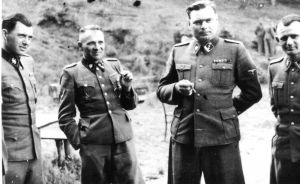Dr Josef Mengele

Mengele, Hoss, Kramer in Sola Hutte
Josef Mengele was born on 16 March 1911 in Gunzberg, near Ulm in Bavaria. He was the eldest son of Karl Mengele, who was a prosperous manufacturer of farming implements and machinery. After studying philosophy in Munich, Mengele obtained his medical degree at the University of Frankfurt am Main. Mengele, a convinced Nazi, became after 1934, a research fellow and staff member of the newly founded Institute of Hereditary Biology and Race Research, where he specialised in the study of twins and racial pedigrees. Here he became an assistant to Dr Ottmar von Verschauer, a leading scientific figure, widely known for his research into twins.
Mengele joined the SS, and he worked as a medical expert for the Race and Settlement Main Office in the summer of 1940, at the Central Immigration Office North East in Posen, today Poznan in Poland. He then joined the Waffen –SS and served as a medical officer in France and later for the SS-
Mengele conducted selections at the Birkenau ‘Judenrampe’ sending thousands of innocent Jewish men, women and children to their deaths in the gas chambers. In Auschwitz-
Those arriving at Birkenau afflicted with any sort of physical deformity would be murdered on his orders, to provide new material for his medical studies. There was a special dissection ward where autopsies of those camp inmates thus killed were performed. Dr Mengele was especially interested in twins and carried out a number of medical experiments, hoping to find a method of creating a race of blue-
Mengele was appointed to the position of Chief Camp Physician of Birkenau in November 1943 under the direct command of Dr Eduard Wirths, who was the Garrison Doctor for Auschwitz, and who had control of all the SS Camp Doctors. On 17 January 1945 Dr Mengele closed down his experimental station in Camp B-
After the defeat of Germany, Mengele was incarcerated in two American controlled Prisoner of War camps in Schauenstein and later Helmbrechts, both near the town of Hof, in Bavaria. Mengele was discharged from Helmbrechts during the first week of August 1945 and made his way towards Munich.
With the aid of false papers Mengele fled via Rome to Buenos Aires in Argentina, and as one of the most wanted Nazi war criminals he was allegedly seen in other South American countries such as Brazil and Paraguay and substantial sums of money were offered for his capture. Mengele was naturalised as a Paraguayan citizen in November 1959. As a result of the capture and trial of Adolf Eichmann, the West German government in Bonn sought the fugitive doctor but all efforts to bring him to justice failed. In 1985, after a large reward had been offered in Israel for information leading to his capture, it was announced that Josef Mengele had probably died in a swimming accident in Embu, Brazil on 7 February 1979.
In July 1985, a body, presumed to be that of Mengele, was exhumed in Brazil and autopsied by an international panel of forensic pathologists. They concluded that there was a high probability that the body was indeed Mengele’s last remains. Although doubt exists in some quarters, the quest for the most wanted Nazi war criminal was now at an end.
Sources:
Robert S Wistrich, Who’s Who in Nazi Germany, Routledge, London 1995
Danuta Czech, Auschwitz Chronicle, Henry Holt and Company, New York, 1990
US Department of Justice Criminal Division – Office of Special Investigations (OSI), In the Matter of Josef Mengele, October 1992
Photograph – Karl Hoecker Album – USHMM
© Holocaust Historical Society 2014

